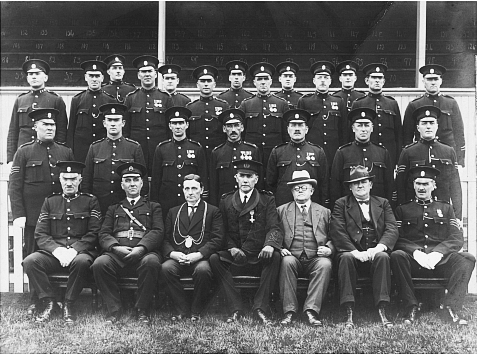John Maxwell

There was an excellent turnout for the Society's meeting on Friday night — despite the wild weather brought in by Storm Erik. Members and guests were treated to a comprehensive guide to the history of policing across Dumfries and Galloway by retired police officer, John Maxwell. John began with a brief outline of his career with Dumfries and Galloway Constabulary. He was drawn to the police force in 1978 — having already established a good career with ICI as a qualified engineer. He went on to serve the region for 30 years. It could be argued that he continues to serve the police force. In retirement, John speaks about its history, and has brought together some of his 15 years of painstaking research to produce the definitive history of the Royal Burgh of Dumfries Police (1788–1932), first published in 2013 under the title Without Fear or Favour. Like his book, John’s talk was illustrated with images of Burgh Police memorabilia, including batons of office, group photographs of policemen and officials, individual portraits of Superintendents and Chief Constables, as well as the places in Dumfries and Maxwelltown that we associate with policing through the decades. John gave an account of the origins of policing in Dumfries and Galloway, the Parliamentary Acts (such as the Police Act of 1811) and the taxes which were put in place to enable improvements to local living standards and public safety. He outlined the development of the burgh, county, Stewartry and municipal policing divisions which amalgamated across the region at various times, ultimately becoming part of Police Scotland in 2013.

Dumfries Burgh Police Force, 1932 (on the date of the amalgamation with the Dumfries County Police). Courtesy of Dumfries Museum.
Perhaps we believe that we live in an area of Scotland where fewer incidents and crimes occurred over the past 200 years, and therefore have less to contribute to the history and development of policing in Scotland? Our speaker detailed several instances in which our region has experienced significant events in policing history, as well as events which tested their skills and resources to the extreme:
- The last public hanging of a female in Scotland (Mary Timney) was in Dumfries in 1862.
- The last public hanging in Scotland (Robert Smith) was in Dumfries in 1868.
- The worst rail disaster in British history occurred at Quintinshill near Gretna in 1915.
- One of the deadliest maritime disasters in British waters was the sinking of the MV Princess Victoria, a British Railways car ferry on the way from Stranraer to Larne in a storm in 1953.
- The worst air disaster in British history occurred when the Pan Am Flight 103 exploded over Lockerbie in 1988.
The region has been at the forefront of change and innovation in policing. Women were employed to police the workforce at HM Gretna Munitions Factory during the First World War. The murder at the Little Ross Lighthouse led to a manhunt across Europe in 1960, and early use of forensic techniques were seen in Moffat when Dr Ruxton’s victims were discovered in a ravine in 1936. John Maxwell patiently answered the audience’s questions and was thanked with an extended round of applause, leaving the audience with a greater appreciation of Dumfries and Galloway’s contribution to the history of policing.
J.T.
